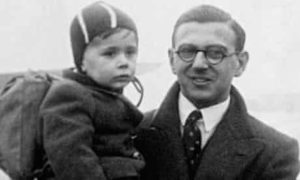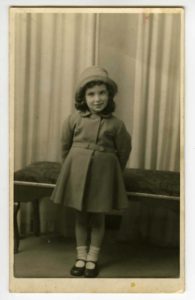Mona Golabek’s tribute to her mother’s experience in the Kindertransport, a rescue mission that sent Jewish children to Britain prior to WWII, is mesmerizing. The Pianist of Willesden Lane, a story of bravery and survival now at 59E59 Theaters, should be required viewing.
In 1988, the BBC program “That’s Life!” aired an episode dedicated to Sir Nicholas Winton, a British stockbroker who rescued 669 mostly Jewish children from Nazi-occupied Czechoslovakia in 1939. In the wake of Sir Nicholas’s 105th birthday last May, a segment from that episode went viral.
“What was the hardest part of your experience during the Kindertransport?” and “How do you feel about Germany today?” are just two of the questions Bordentown Regional Middle School students asked of Holocaust survivor Norbert Bikales during his visit to the school on May 30. Mr. Bikales told the audience of 180 eighth-graders, teaching staff, and administrators, how, as a 9-year-old in Berlin, he heard that his father and 17-year-old brother had been arrested.
This is a story which started 76 years ago when the Nazis kicked my family out of our home in Unna. My brother Siegfried and I were refugee children who survived while my parents and sister did not. Today, I am retracing the story back to my home town with my wife, three children, their spouses, and my grandchildren. I am excited to embark on this journey and would love to share it with you. Please follow my odyssey at odyssey76.com where we will be uploading daily updates.
In late April, the CBS program “60 Minutes” aired an extraordinary report titled “Saving the Children,” about Sir Nicholas Winton, an Englishman who in 1939 helped 669 children, mostly Jews, escape Nazi persecution in Czechoslovakia. Renata Laxova was one of those kids. Laxova, 82, is an emeritus professor of genetics at UW-Madison. Last week, she sat at a shaded table in the backyard of her North Side home and recalled the year when she was 8 years old, and the whole world changed.
Every spring, on Holocaust Remembrance Day, those who died under Nazi persecution are honored in ceremonies throughout the world; and those who survived it recall what they experienced. Anita Weisbord is among them. When Hitler’s army annexed Austria to the German Reich in March of 1938, Weisbord’s homeland suddenly became unrecognizable. “That was the end of my childhood as I knew it,” recalls Weisbord today, “Overnight, Jews became non-persons. We lost all our rights.”
The story of Sir Nicholas Winton is one of the most profound tales of humanitarianism that you’ve probably never heard. After saving 669 children, most of them Jewish, from likely death at Nazi concentration camps at the onset of World War II, it was announced Monday — on Winton’s 105th birthday — that the heroic Englishman will be awarded the Order of the White Lion, the highest order in the Czech Republic. The award will be given to Winton this October.

Nicholas Winton with one of the children he rescued. Courtesy Bee’s Knees Productions
A man nicknamed the British Oskar Schindler, who saved hundreds of Jewish children from the Nazis before the second world war and on Monday celebrated his 105th birthday, is to receive the highest honour in the Czech Republic. Sir Nicholas Winton enabled 669 children – mostly Jewish – to escape from the German-occupied country, and come to Britain just before war broke out in September 1939. Many of the children’s families were murdered in Nazi concentration camps.
An archivist makes a stunning find after a 60 Minutes story airs about Sir Nick Winton, the Londoner who saved 669 children from the Nazis. Last month, 60 Minutes correspondent Bob Simon told the remarkable story of Sir Nicholas Winton, a stockbroker in London who saved 669 Czech children from the Nazis during WWII. He said he had written a letter to President Franklin D. Roosevelt, describing the plight of the Czech children and asking that America grant refuge to a number of them.
A Berlin-based artists’ collective is pressuring the German government to take in more Syrian asylum seekers. It is supported by two Berlin Jews who survived the Holocaust thanks to asylum via the KIndertransport in the UK. Grateful for their fate, they now want to help Syrian children escape the civil war raging in their country.
The Association of Jewish Refugees represented Britain at last week’s inauguration of a Kindertransport statue in Hamburg, Germany. Sir Erich Reich, Andrea Goodmaker and Carol Rossen from AJR were among the first to see the bronze sculpture, called The Last Farewell, by internationally acclaimed artist Frank Meisler, himself a Kind.
In the five-year run of Dandelions Flowers and Gifts’ “Eugene’s Favorite Mom” award, there had never been a nomination letter quite like it. Written by brothers Sidney and Kenneth Brown, the essay described the remarkable life story of their mother, Charlotte Brown, who turned 90 on April 2.

Walter Kohn
Nobel laureate and professor emeritus of physics at USCB, KTA member Walter Kohn recalls life under the Austrian Nazi regime, the death of his parents at Auschwitz and the good people who rescued him. On Dec. 2, 1938, a train pulled into Harwich, England. On board were 196 children from a Jewish orphanage in Berlin that had been destroyed during Kristallnacht (Night of Broken Glass). Part of the first “Kindertransport,” the children were on their way to foster homes in Britain.
The Kindertransport will be the focus of several events in May in Utica and Rome, NY. At 2 p.m. on May 18, Karl Buchholz, a Kindertransport survivor, will speak at the Jewish Community Center in Utica. The play by Diane Samuels, “Kindertransport,” will be presented at 7:30 p.m. June 5-7 at Rome Community Theater, with a 2:30 p.m. matinee June 8. The Kindertransport Association Exhibition Panels will be on display at the theater.
n observance of Yom HaShoah, congregants at Beth Hillel Congregation Bnai Emunah, Wilmette gathered for a special memorial service on Sunday evening, April 27. The program highlighted children of the Holocaust. Each person attending lit a candle in memory of those that perished. Two hidden children and one individual that was part of the Kindertransport shared their emotional and unforgettable stories of survival.
Briton Nicholas Winton helped save hundreds of mostly Jewish children from Nazi-occupied Czechoslovakia on the eve of the war. “Saving the Children”aired on April 27, 2014 on CBS news program 60 Mnutes. Bob Simon is the correspondent. Harry Radliffe and Vanessa Fica, producers. Watch the video and read the transcript online: http://www.cbsnews.com/news/saving-the-children-during-world-war-11-60-minutes/
The story of how KTA member Alice Eberstark and her two sisters made it onto one of Winton’s trains is the subject of this week’s 60 Minutes Overtime feature. “Alice has one of the most heart-wrenching stories to tell,” says Radliffe. “She remembers very clearly, before they left home, her father sitting on the edge of the bed, sobbing uncontrollably. They clearly had debated whether this was the right thing or not.”
Notizen aus England: Zug ins Ungewisse Eine Reise ins Ungewisse: Eltern und Kinder wussten nicht, ob sie einander jemals wiedersehen würden. 75 Jahre nach dem ersten Kindertransport erzählen drei Deutsche von dieser Reise und ihrem Leben danach. Und der Dokumentarfilmer Sir David Attenborough erinnert sich an die beiden deutschen Mädchen, die in seiner Familie aufgenommen wurden.
Otto Decker, saved by the Kindertransport rescue mission before World War II broke out, shared his story of survival during a recent Forum discussion group meeting in West Delray’s Vizcaya community. Decker, 84 and a Boca Raton resident, was born in Wiesbaden, Germany. He was one of a group of 50 Jewish children who were sent to Frankfurt by their German parents in 1938 to live together in safety.

My sister Bertl doesn’t call herself a Holocaust survivor, says Starobin, 76, taking her red glasses off. She won’t put them on again until she has finished telling her story almost two hours later. “She says we weren’t in a camp. But you know what? I lost my parents. I lost my home. I was resettled without having a say in it. That seems to me as pretty much being a survivor.”
Esther Starobin is interviewed by Lilly Maier.